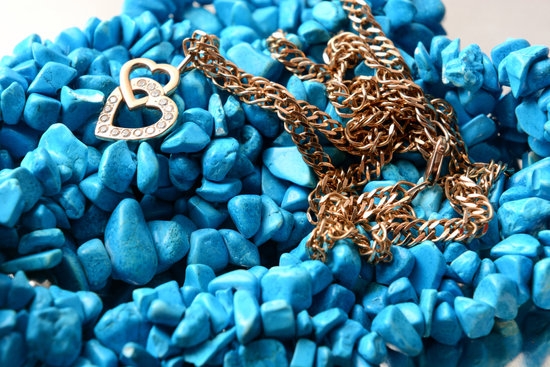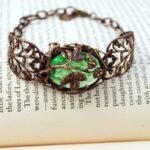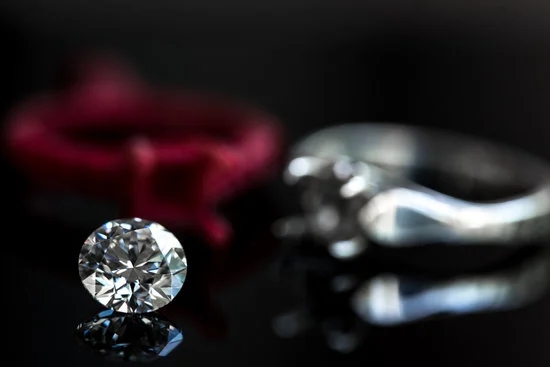Are you interested in learning how to make handmade jewelry with wire? Whether you’re a seasoned jewelry maker looking to expand your skills or a beginner eager to explore a new creative outlet, wire jewelry making offers endless possibilities for artistic expression.
The appeal of handmade jewelry lies in the unique, one-of-a-kind pieces that can be created, as well as the freedom to bring your own vision to life. From delicate earrings to statement necklaces, handmade wire jewelry allows for endless customization and personalization.
The practice of making jewelry with wire has been around for centuries, with evidence of wire wrapped earrings and pendants dating back to ancient civilizations. Today, modern artisans continue to explore the art of wire jewelry making, combining traditional techniques with innovative designs. In this article, we will delve into the world of handmade jewelry with wire, covering everything from choosing the right materials and tools to step-by-step project tutorials and tips for selling your creations.
Whether you’re drawn to the organic look of twisted copper wire or the sleek elegance of sterling silver, there are countless types of wire available for creating handmade jewelry. Understanding the characteristics and uses of different wires is essential for executing your design vision. So let’s dive into the world of wire jewelry making and discover how you can unleash your creativity through this timeless craft.
Choosing the Right Wire for Your Project
When it comes to creating handmade jewelry with wire, choosing the right type of wire for your project is essential. The type of wire you use can greatly impact the final look and durability of your jewelry piece. There are several factors to consider when selecting wire, including gauge, material, and hardness.
Here are some things to keep in mind when choosing the right wire for your project:
- Gauge: The gauge of a wire refers to its thickness. Thicker gauges are stronger and more durable, while thinner gauges are more flexible and better suited for intricate designs.
- Material: Wire comes in a variety of materials, including sterling silver, copper, brass, and gold-filled. Each material has its own unique properties and characteristics, so consider the look and feel you want for your jewelry piece.
- Hardness: Some wires come in different levels of hardness, such as half-hard or dead-soft. Hardness can affect how easy the wire is to manipulate and shape, so choose the appropriate hardness for your specific design needs.
Once you have a good understanding of these factors, you can make an informed decision about the type of wire that will best suit your handmade jewelry project. It’s important to remember that experimentation is key – don’t be afraid to try out different types of wire to see what works best for you.
Another important consideration when choosing wire for your handmade jewelry project is the color and finish of the wire. Some wires come in a natural metal finish, while others are coated with colored enamel or other finishes. Consider how the color and finish of the wire will complement your overall design aesthetic.
In addition to considering these factors when choosing wire for your project, beginners may want to start with softer metals such as copper or brass as they are easier to work with than harder metals like sterling silver or gold-filled wire. As you gain more experience with making handmade jewelry with wire, you can gradually expand your materials and techniques.
Essential Tools and Equipment
Crafting handmade jewelry with wire requires a variety of essential tools and equipment to effectively bring your designs to life. The following list outlines the necessary items you will need to get started, as well as some tips for finding quality tools on a budget.
One of the most important tools for wire jewelry making is a good pair of round-nose pliers, which are used for creating loops and curves in the wire. Additionally, chain-nose pliers are essential for gripping and bending the wire, while also being useful for opening and closing jump rings. A flush cutter is another must-have tool, as it allows you to cleanly cut through wire without leaving sharp edges.
When it comes to selecting your tools, it’s important to invest in quality items that will withstand regular use. However, if you’re working with a limited budget, there are plenty of affordable options available. Many craft stores and online retailers offer beginner tool kits specifically designed for wire jewelry making that include all of the essential items at a reasonable price.
Another cost-effective option is to purchase second-hand tools from local yard sales or online marketplaces. While used tools may show signs of wear, they can often be cleaned up and restored to like-new condition with proper care and maintenance. With a little creativity in your search, you can find quality tools without breaking the bank.
| Tool | Use |
|---|---|
| Round-nose pliers | Creating loops and curves in the wire |
| Chain-nose pliers | Gripping, bending wire; opening/closing jump rings |
Basic Techniques for Wire Jewelry Making
Wire Wrapping
Wire wrapping is a fundamental technique in making handmade jewelry with wire. It involves using pliers to bend and twist wire around itself or other elements to create intricate designs. To start, you will need a length of wire, typically in copper or sterling silver, and jewelry pliers.
Begin by creating a small loop at the end of the wire using round-nose pliers. Then, use chain-nose pliers to grip the end of the wire and wrap it around itself to create decorative shapes or secure beads in place.
Coiling
Coiling is another essential technique for creating unique wire jewelry designs. This involves wrapping wire around a mandrel or dowel rod to create tightly wound coils that can be used for earrings, pendants, or other components. Choose your desired gauge of wire and wrap it tightly around the mandrel, ensuring even spacing between each coil. Once you have achieved the desired length of coiled wire, carefully slide it off the mandrel and trim any excess.
Looping
Looping is a versatile technique that allows you to create loops of various sizes and shapes for connecting different elements of your handmade jewelry. You can use round-nose pliers to create simple loops for attaching charms or beads, or you can experiment with different plier shapes to achieve more intricate loop designs. Practice creating consistent loops by adjusting your grip on the pliers and experimenting with different gauges of wire.
Learning these basic techniques for wire jewelry making is essential for mastering the art form and creating stunning handmade pieces. With practice and patience, you can expand upon these techniques and develop your own unique style in crafting beautiful jewelry from wire.
Design Inspiration
When it comes to making handmade jewelry with wire, the design possibilities are endless. Whether you prefer a minimalist, modern aesthetic or intricate, bohemian designs, wire jewelry offers a unique and versatile medium for creative expression. The following are some design inspiration tips to help you develop your own unique style:
- Explore different styles and aesthetics: Take the time to explore various styles of wire jewelry, such as minimalist geometric designs, nature-inspired pieces featuring gemstones and crystals, or intricate woven wire patterns. Look for inspiration in fashion trends, art movements, and nature to develop your own signature style.
- Find inspiration in everyday objects: Sometimes everyday objects can spark creative ideas for unique jewelry designs. Look around you for simple shapes, patterns, and textures that could be translated into wire jewelry. For example, the pattern of a leaf or the structure of a building could serve as inspiration for a new piece.
- Experiment with different materials: Don’t limit yourself to just using wire in your designs. Consider incorporating other materials like beads, gemstones, leather cord, or fabric into your pieces to add texture and visual interest.
By exploring these sources of inspiration and experimenting with different materials and techniques, you can develop a strong foundation for creating original and eye-catching handmade wire jewelry pieces that showcase your unique creativity.
Step-by-Step Project Tutorials
Creating a Wire-Wrapped Pendant
One of the most popular and versatile projects for beginners in wire jewelry making is creating a wire-wrapped pendant. To start, you will need a gemstone or other focal bead, as well as wire in your desired gauge and material.
Begin by wrapping the wire around the stone to create a secure cage-like structure, then use additional wire to form decorative accents and a bail for hanging the pendant. This project allows for endless customization, from choosing different stones to experimenting with various wrapping techniques.
Wire-Loop Earrings
Another simple yet impressive project is crafting wire-loop earrings. You will need wire in your chosen gauge, as well as beads or charms if desired. Start by creating a small loop at one end of the wire, then adding your chosen beads or charms before forming a second loop at the other end to secure them in place. These earrings can be made in various sizes and styles, from dainty and delicate to bold statement pieces.
Wire-Wrapped Ring
For those interested in making wearable art, creating a wire-wrapped ring is an excellent project to try. You’ll need a ring mandrel or cylindrical object for shaping, along with wire in your preferred gauge and material. Begin by forming the base of the ring around the mandrel, then add decorative twists, coils, or beads using additional wire. This project allows for endless creativity and personalization while producing stunning handmade jewelry.
These step-by-step tutorials are just a starting point for exploring the world of handmade jewelry with wire. As you become more comfortable with these basic projects, you can begin incorporating more advanced techniques and designs into your creations. With dedication and practice, you can develop your skills and create unique pieces that reflect your personal style and artistic vision using how to make handmade jewelry with wire principles.
Finishing and Polishing Your Handmade Jewelry
After you have completed creating your handmade wire jewelry, it is important to ensure that it looks as professional and polished as possible before wearing or selling it. Regardless of the style or design you have chosen, there are a few key techniques for finishing and polishing your pieces that will give them a more refined appearance.
Firstly, cleaning wire jewelry is essential to remove any dirt, dust, or residues from the materials used in its creation. Using mild soap and water along with a soft brush can help clean the metal wires without causing any damage. For pieces with gemstones or other delicate materials, it’s important to use caution and do some research on proper cleaning methods to avoid causing any harm.
Once cleaned, shining your wire jewelry can be accomplished using a polishing cloth specifically designed for metal such as silver or gold. When using a polishing cloth, gentle movements along the length of the piece can restore its shine without scratching. For pieces that require more extensive polishing due to tarnishing or wear, there are also specialized jewelry polishes available that can help restore their luster.
Finally, adding clasps and other finishing touches is crucial to ensuring that your handmade wire jewelry is both attractive and functional. Whether you choose lobster clasps or toggle clasps, make sure they match the overall aesthetic of your piece so that they contribute positively to its overall appeal.
The process of finishing and polishing your handmade wire jewelry is an essential step in achieving a professional-looking final product. With these techniques in mind, you can ensure that your creations look polished and appealing whether for personal enjoyment or potential sale.
| Wire Jewelry Finishing & Polishing Techniques | Details |
|---|---|
| Cleaning | Use mild soap & water with soft brush for metal; research proper methods for gemstones. |
| Shining | Use a specialized polishing cloth for metal; consider using jewelry polish for more extensive wear. |
| Add Clasps & Finishings | Choose appropriate clasps matching the aesthetic of the piece. |
Selling Your Handmade Jewelry
In conclusion, learning how to make handmade jewelry with wire can be a rewarding and fulfilling creative pursuit. As discussed in this article, the process involves choosing the right wire for your project, acquiring essential tools and equipment, mastering basic techniques, finding design inspiration, and completing step-by-step projects. Additionally, we explored finishing and polishing techniques as well as tips for selling your handmade jewelry.
By following the comprehensive guide provided in this article, you can develop the skills and knowledge needed to create beautiful wire jewelry pieces. Whether you’re interested in making jewelry for personal use or hoping to turn your hobby into a small business, the information presented here serves as a valuable resource. The step-by-step tutorials and design inspiration sections offer practical guidance for creating unique and customizable wire jewelry.
Furthermore, selling your handmade jewelry is made more accessible through the tips provided in this article. By understanding how to price and market your creations effectively, you can share your passion for handmade jewelry with others while also potentially generating income from your craft. Ultimately, making handcrafted wire jewelry offers endless creative possibilities and allows you to express your individual style through wearable art forms.
Frequently Asked Questions
How Do You Make Wire Jewelry for Beginners?
Making wire jewelry for beginners can be a fun and creative process. Start by gathering essential tools like pliers, wire cutters, and round-nose pliers. Choose a beginner-friendly wire gauge such as 20 or 22, and practice making simple loops and basic wire wraps to build your skills.
What Wire Is Best for Making Jewelry?
The best wire for making jewelry varies depending on the specific project and personal preference. Generally, copper, sterling silver, and gold-filled wires are popular choices due to their malleability and durability. It’s important to consider factors like hardness, gauge, and color when selecting the best wire for a particular jewelry design.
How Do You Bend Wire for Jewelry?
Bending wire for jewelry requires the use of proper tools like round-nose pliers, chain-nose pliers, or nylon jaw pliers to avoid marring the wire’s surface. To create smooth bends, grip the wire with the pliers and gently apply pressure to manipulate it into the desired shape. Practice is key to mastering this skill.

Welcome to my jewelry blog! My name is Sarah and I am the owner of this blog.
I love making jewelry and sharing my creations with others.
So whether you’re someone who loves wearing jewelry yourself or simply enjoys learning about it, be sure to check out my blog for insightful posts on everything related to this exciting topic!





